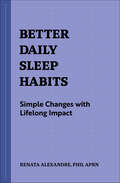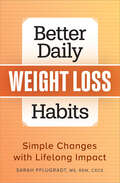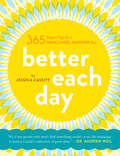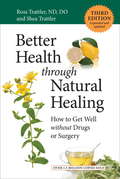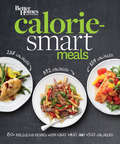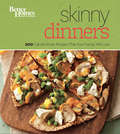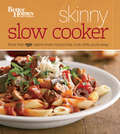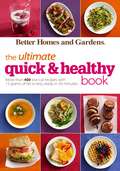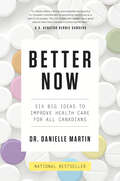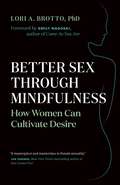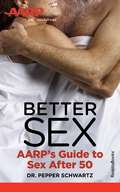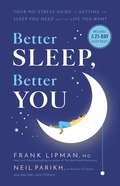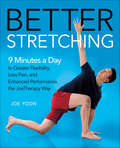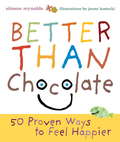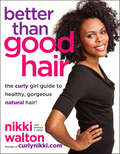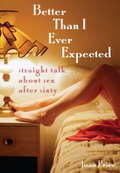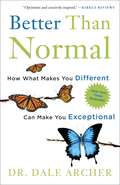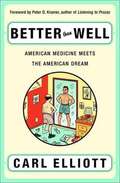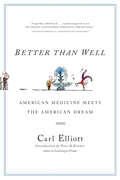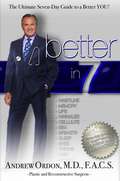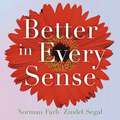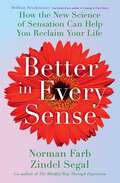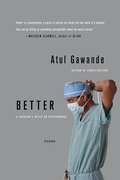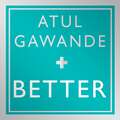- Table View
- List View
Better Daily Sleep Habits: Simple Changes with Lifelong Impact (Better Daily Habits)
by Renata AlexandreBuild long-term habits for a lifetime of better sleepStart sleeping better every night! Filled with straightforward and easy-to-implement advice, this book's expert guidance helps you build beneficial sleeping habits while putting an end to bad ones. You'll be waking up rested and ready to face the day in no time.Sleep smarter with:Simple adjustments—Learn how to create a sleep schedule, establish bedtime routines, eat wisely, and more in just a few steps.Relatable stories—Understand the effectiveness of these habit changes thanks to stories that demonstrate how they benefited actual sleep patients.Progress tracking—See how far you've come and keep yourself on the right track using the helpful habit trackers included with each chapter.Start sleeping better tonight with Better Daily Sleep Habits.
Better Daily Weight Loss Habits: Simple Changes with Lifelong Impact (Better Daily Habits)
by Sarah Pflugradt MS, RDN, CSCSCreate healthy habits for long-lasting weight loss Dropping a few pounds quickly with the latest trendy diet can be exciting—but keeping pounds off for good comes from establishing healthy habits. Achieve your weight loss goals with this book's simple lifestyle changes that promote mindful meal planning, clean eating, and healthy living. Build better habits—Infuse your everyday life with easy, healthy habits like drinking enough water, exercising, and eating more fiber to keep you moving in the right direction. Watch your progress—A daily weight loss tracker lets you record your actions to see the success of your health journey. Understand routine and wellness—Create a regular routine that makes it easier to eat right, get quality sleep, and feel more in control of your choices. Achieve your health goals one day at a time with this essential weight loss book.
Better Each Day: 365 Expert Tips for a Healthier, Happier You
by Jessica Cassity365 expert tips based on scientific findings to help you boost your confidence, get fit, fight off worry and fear, improve your relationships, and more.New Year’s resolutions have never been easier to keep than with Better Each Day. Its hundreds of tips add up to a big impact on your well-being. Using the latest scientific findings from experts in the fields of nutrition, mental health, fitness, and psychology, respected journalist Jessica Cassity presents 365 proven and easy-to-achieve tips for feeling more confident, getting fit, clearing away worry and fear, improving relationships, and much more. Readers can work the tips day by day, or dip in and out of the book at will. With fascinating facts on the science behind self-improvement, this is an engaging and inspiring read perfect for anyone looking to feel healthier, and, of course, happier!“Chock-full of fitness, health, nutrition, relationship, and just general feel-good advice.” —Shape magazine“Author Jessica Cassity gives you enough techniques and tips to help boost your happiness and well-being every single day for an entire year.” —SELF magazine
Better Health through Natural Healing, Third Edition
by Shea Trattler Ross TrattlerThe definitive reference book for alternative medicine, health and healing, nutrition, herbs and herbal medicine, and natural health care is fully updated in this third edition. First published in 1985, Better Health through Natural Healing has become one of the most successful and authoritative resources of its type, with more than 1.5 million copies sold worldwide. Since the original publication of this comprehensive guide, alternative therapies have become more and more accepted by the mainstream, and patients and practitioners of the wider medical community are embracing complementary medicine as an effective treatment option for a range of medical conditions.This third edition has been fully revised by Dr. Ross Trattler with the assistance of his son, osteopath Shea Trattler, to encompass recent developments in holistic medicine and healing.The first part of the book clearly explains the principles of natural medicine, including diet, osteopathy, naturopathy, botanical medicine, hydrotherapy, physiotherapy, and homoeopathy. The second part offers practical advice for the treatment of over 100 common diseases and ailments that individuals and families face. The A-Z compendium ranges from acne and alcoholism to menstrual disorders and migraines to warts and whooping cough.A comprehensive self-help guide to natural medicine, Better Health through Natural Healing is an essential reference book for health care practitioners and for anyone seeking to heal illness effectively with natural treatments.
Better Homes and Gardens Calorie-Smart Meals: 150 Recipes for Delicious 300-, 400-, and 500-Calorie Dishes (Better Homes and Gardens Cooking)
by Better Homes and GardensThe perfect companion for cooking delicious and varied meals that fit into a healthy eating plan Better Homes and Gardens Calorie-Smart Meals is a must-have recipe collection of tasty meals that don't break the daily calorie bank. This is an easy-to-use, modern guide to preparing simple, healthful dishes, with chapters organized by calories, covering meals under 300, 400, and 500 calories plus snacks under 200 calories and desserts under 250 calories. With more than 150 recipes and more than 100 gorgeous photos, the book helps cooks make health-conscious meals such as Peruvian-Style Chicken Tacos (under 300 calories), Pumpkin-Parmesan Risotto (300-400), and Wild Mushroom Ravioli Skillet (400-500). Each calorie level includes recipes good for breakfast, lunch, and dinner, so cooks have flexibility to put together a meal plan that suits their lifestyle, calorie needs, and preferences.
Better Homes and Gardens Skinny Dinners
by Better Homes and Gardens180 simple, nutritious, low-cal dishes for every night of the week For people looking to cook healthy meals or watching their weight, here are 180 simple, modern recipes for dishes that never feel like a sacrifice--all under 400 calories. With 150 gorgeous recipe photos; nutrition information for every recipe; icons identifying high-fiber, vegetarian, and gluten-free recipes; healthy-eating tips; and Make-It-a-Meal menu ideas for all main-dish recipes, this will be an inspiring, go-to guide for everyday cooking. Family-pleasing dishes include Barbecue Chicken Pot Pie, Turkey Meatball Grinders, Personal Ham and Sweet Potato Pizzas, Macaroni Alfredo with Pumpkin and Kale, plus satisfying desserts, like Dumplings with Orange Sauce.
Better Homes and Gardens Skinny Slow Cooker
by Better Homes and GardensA slow cooker is the ultimate convenience appliance: it allows you to have a healthful dinner your whole family will love when they get home. Better Homes and Gardens Skinny Slow Cooker will help you eat delicious, hearty food and feel good about feeding your family one meal instead of cooking multiple dishes. Every time you turn to this book, you'll know that any of the 150 recipes will provide nutritious, hearty meals. Every recipe, for dishes like Spiced Pork with Squash and Vegetable Stew with Cornmeal Dumplings, features calorie counts and nutrition information. Tips will help you make healthful choices when you shop and cook, and the more than 100 photos and bright design will turn this inspiring collection into an everyday resource.
Better Homes and Gardens Skinny Slow Cooker
by Better Homes and GardensA slow cooker is the ultimate convenience appliance: it allows you to have a healthful dinner your whole family will love when they get home. Better Homes and Gardens Skinny Slow Cooker will help you eat delicious, hearty food and feel good about feeding your family one meal instead of cooking multiple dishes. Every time you turn to this book, you'll know that any of the 150 recipes will provide nutritious, hearty meals. Every recipe, for dishes like Spiced Pork with Squash and Vegetable Stew with Cornmeal Dumplings, features calorie counts and nutrition information. Tips will help you make healthful choices when you shop and cook, and the more than 100 photos and bright design will turn this inspiring collection into an everyday resource.
Better Homes and Gardens The Ultimate Quick & Healthy Book
by Better Homes GardensModern home cooks are concerned with getting healthy food on the table quickly, and Better Homes and Gardens The Ultimate Quick & Healthy Book offers the perfect solution. Included are 400 recipes ready in 30 minutes or less, and every main dish has fewer than 450 calories and 15 grams of fat. This book proves that quick cooking and healthy cooking can be synonymous. There are recipes for every occasion, from breakfast to dinner to make-ahead meals and entertaining. Every recipe includes full nutritional information and handy icons that highlight Superfast, No-Cook, Vegetarian, and Heart Healthy dishes. With more than 180 full-color photographs, the book is as beautiful as it is practical.
Better Now: Six Big Ideas to Improve Health Care for All Canadians
by Danielle MartinDR. DANIELLE MARTIN see the challenges in our health care system every day. As a family doctor and a hospital vice president, she observes how those deficiencies adversely affect patients. And as a health policy expert, she knows how to close those gaps. A passionate believer in the value of fairness that underpins the Canadian health care system, Dr. Martin is on a mission to improve medicare. In Better Now, she shows how bold fixes are both achievable and affordable. Her patients’ stories and her own family’s experiences illustrate the evidence she presents about what works best to improve health care for all. Better Now outlines “Six Big Ideas” to bolster Canada’s health care system. Each one is centred on a typical Canadian patient, making it clear how close to home these issues strike. · Ensure every Canadian has regular access to a family doctor or other primary care provider · Bring prescription drugs under medicare · Reduce unnecessary tests and interventions · Reorganize health care delivery to reduce wait times and improve quality · Implement a basic income guarantee to alleviate poverty, which is a major threat to health · Scale up successful local innovations to a national level Passionate, accessible, and authoritative, Dr. Martin is a fervent supporter of the best of medicare and a persuasive critic of what needs fixing.
Better Sex Through Mindfulness: How Women Can Cultivate Desire
by Emily Nagoski Lori BrottoA groundbreaking look at improving desire, arousal, and sexual satisfaction through mindfulness. <P><P>Studies show that approximately half of all women experience some kind of sexual difficulty at one point in their lives, with lack of interest in sex being by far the most common―and the most distressing. And when sex suffers, so do all other areas of life. <P><P>But it doesn’t have to be that way. In Better Sex through Mindfulness, acclaimed psychologist and sex researcher Lori A. Brotto, offers a groundbreaking approach to improving desire, arousal, and satisfaction inside―and outside of―the bedroom. A pioneer in the use of mindfulness for treating sexual difficulties, Brotto has helped hundreds of women cultivate more exciting, fulfilling sexual experiences. In this accessible, relatable book, she explores the various reasons for sexual problems, such as stress and incessant multitasking, and tells the stories of many of the women she has treated over the years. She also provides easy, effective exercises that readers can do on their own to increase desire and sexual enjoyment, whether their goal is to overcome a sexual difficulty or simply givetheir love life a boost.
Better Sex: AARP’s Guide to Sex After 50
by Dr Pepper SchwartzStudy after study has shown that sex is highly correlated to happiness and health—for people of all ages. Why should aging make us give that up?Dr. Pepper Schwartz has the answers. Her career as a sex expert has ranged from founding a support group in her home as an adolescent to appearing on national television. Now an expert on the hit TV show Married at First Sight, a professor at the University of Washington and the author or co-author of 22 books on the topic, Dr. Schwartz teaches you how to have the best sex ever, and answers all those questions you’ve been wondering about: - How many climaxes are normal? - What do I do if sex just isn’t working anymore? - What are the best grownup steamy movies? - How can I get around medical conditions such as backaches, low testosterone, and knee replacement surgery? - STDs and condoms—really? At my age?A blogger and writer for AARP, Dr. Schwartz specializes in all topics related to relationships and sex. No question is too embarrassing for Dr. Schwartz, and no answer is taboo. In this book, she’ll show you how your dialogues about sex can mature alongside you, bringing you more happiness, better health—and better sex.
Better Sleep, Better You: Your No-Stress Guide for Getting the Sleep You Need and the Life You Want
by Frank Lipman Neil ParikhSleep is the most important part of anyone&’s journey to a healthy and happy life, and with this book you can learn how to fix your sleep schedule and recover precious hours of relaxation.If you're like most people, odds are you aren't getting enough sleep. Thanks to shifts in our culture America is in the midst of an epidemic of sleeplessness, and unfortunately, sleep deprivation has bigger consequences than one might think, ranging from irritability, brain fog, and weight gain to serious conditions like hormone dysregulation, heart disease, memory impairment, diabetes, and Alzheimer's.In Better Sleep, Better You, functional medicine pioneer and sleep expert Frank Lipman, MD, and Casper co-founder Neil Parikh team up to offer a one-stop resource to help you reap the benefits of sleeping well every night. Unlike the dozens of articles offering a "quick fix" for insomnia, Lipman and Parikh understand that there's no such thing as a one-sleep-fits-all solution. By clearly explaining the latest developments in sleep science and all the factors that affect your sleep—including when and how you eat and exercise, how you handle stress, how you nap, and how you engage with technology—Better Sleep, Better You helps readers create a personalized sleep protocol that works for their lifestyle and needs.Packed with fascinating science, engaging case studies, and easy-to-implement practical advice, Better Sleep, Better You provides everything you need to optimize your sleep, productivity, and happiness—for life.
Better Stretching: 9 Minutes a Day to Greater Flexibility, Less Pain, and Enhanced Performance, the JoeTherapy Way
by Joe YoonAchieve life-changing results for your body—greater mobility, better functionality, enhanced performance, and less pain—in as little as 9 minutes a day. In Better Stretching, Joe Yoon brings you the tips and techniques he gives world class athletes, and provides you with an entirely new way to think about stretching. You won’t need 90 complicated minutes to get more agile—you’ll just need 9! And your results will improve dramatically—and stay that way—when you incorporate just a touch of mobility and strengthening to your stretches. Joe Yoon shows you how.Better Stretching debunks myths and misconceptions. You’ll discover:· Over 100 wide-ranging stretches, from static to dynamic, including simple stretches you can do while sitting at your desk · Three 30-day plans designed to give you maximum results in a minimum amount of time, each tailor-made for goals that you choose · Stretching, strengthening, and mobility exercises for people at every level – whether you’re a beginner or advanced, a weekend warrior or a competitive athlete, a business executive or a new parent· Muscle-soothing self-massage techniques using simple foam rollers and tennis balls· Over 125 photographs of Joe demonstrating his stretches, so you achieve results beyond what you thought possible
Better Than Chocolate
by Siimon ReynoldsWhat could possibly be better than chocolate? How about good health, self-acceptance, loving relationships, freedom from fear and guilt, and a clear sense of purpose in life? In BETTER THAN CHOCOLATE, happy guy Siimon Reynolds offers 50 bites of delightful wisdom that are guaranteed to boost your mood instead of your blood sugar. From Taoism to psycho-cyberkinetics, this delicious little book distills simple lessons from the world's major theories about happiness, such as:Ask uplifting questions (they can change the direction of your thinking).Try a low-insulin diet (balancing sugar levels sweetens your mood).Understand Buddhist theory (fewer desires leads to less suffering).Kiss someone (kissing just feels great).Animated with cheery illustrations, BETTER THAN CHOCOLATE is sweeter than a candy bar baked into a brownie and dipped in hot fudge-and a whole lot better for you. From the Hardcover edition.
Better Than Good Hair: The Curly Girl Guide to Healthy, Gorgeous Natural Hair!
by Ernessa T. Carter Nikki WaltonThe fresh new handbook on how to achieve and maintain stylish natural hair, from the savviest and most revered expert on coils and curlsThese days there's a revolution going on. Relaxers are out. Weaves are so yesterday. Tired of damage from expensive chemical treatments and artificial enhancers, women of color are going natural thanks to Nikki Walton of CurlyNikki.com, the natural hair blogger and online hair therapy expert.In Better Than Good Hair, this gifted "curl whisperer" educates women on how to transition from relaxed to completely natural hair, with advice and styles for every length—from Fierce Braid-and-Curls to Fancy Faux Buns. She also counsels those considering the "big chop"—cutting it all off at once to sport a bold and beautiful "teeny weeny afro." Here, too, is essential guidance for parents of mixed-race children dealing with new and unfamiliar hair textures and styles.Combining Walton's expansive knowledge with tips from other experts in the field, Better Than Good Hair includes:Product recommendationsHome hair care recipesAdvice for parents on how to manage their children's natural hair Tips for using henna on gray hair Guidance on dealing with detractors Step-by-step illustrated directions for nearly two dozen hairdos, from frohawks to twist-outsFull of indispensable information, as empowering as it is accessible, and with a foreword by actress and comedian Kim Wayans, Better Than Good Hair is a must-have natural hair care bible that will help women of all ages and styles achieve their natural beauty.
Better Than I Ever Expected: Straight Talk About Sex After Sixty
by Joan PriceBetter Than I Ever Expected is a warm, witty, and honest book that contends with the challenges and celebrates the delights of older-life sexuality. It asserts that women over sixty are at the top of their game when it comes to enjoying sex.Joan Price's woman-to-woman straight talk transcends the self-help style of other books in this field. Yes, there are challenges to sex after menopause and beyond, says Price, but there are also creative solutions. She is on a mission to let women her age and older know that they can, in fact, have the best sex of their lives. Price gets personal and stays positive, combining her own story with candid comments, tips, and sassy tales from sexually seasoned women. She acknowledges the gritty issues that older women confront in their sexual lives, noting that it's not easy, but it certainly isn't over.At age 61, Price is newly engaged to the man she's been looking for her whole life. Her discovery of how great "well-seasoned" sex can be was the inspiration for this book. Sidebars present candid and friendly sex tips; fitness, exercise, and lifestyle information; and women's erotic vignettes-both real-life experiences and fantasies.
Better Than Normal: How What Makes You Different Can Make You Exceptional
by Dale ArcherA groundbreaking new view of human psychology that shows how eight key traits of human behavior--long perceived as liabilities--can be important hidden strengths.What if the inattentiveness that makes school or work a challenge holds the secret to your future as an entrepreneur? What if the shyness in groups that you hate is the source of deep compassion for others? What if the anxiety and nervousness you often feel can actually help energize you? What if the mood swings you sometimes experience canbe the source of tremendous creativity? Renowned psychiatrist and popular on-air personality Dr. Dale Archer believes that labels for behavior like "ADHD," "bipolar," and "OCD" are normal human qualities--and contends that we all experience these and other psychological traits to some extent, yet fail to leverage the significant advantages they can offer. Worse, we stigmatize one another for these prevalent, widely shared aspects of our personalities.In Better Than Normal, Dr. Archer offers an empowering framework for redefining what constitutes mental health. Drawing on his twenty years of clinical experience, he describes eight traits of human behavior--heretofore knownonly as psychiatric diagnoses. Each of these occurs along a continuum rather than as a simple on-off switch (where "off " means we're fine, and "on" means we've got a problem). These are the aspects of our personality that we worry about the most, but these are also the very things that make us distinctive and different.According to Dr. Archer, each of us has a unique personality that emerges from our hardwired genetics and individual life experiences. With Better Than Normal, you can map your individual characteristics by taking the eight traitself-assessment quiz and see how what makes you different can indeed make you exceptional. Filled with engaging anecdotes and practical tools to help you capitalize on your unique characteristics, Better Than Normal offers a new and liberating way to look at ourselves and others.
Better Than Well: American Medicine Meets the American Dream
by Carl ElliottPsychology aspects of medical options
Better Than Well: American Medicine Meets the American Dream
by Carl Elliott Peter D. Kramer"Elliott's absorbing account will make readers think again about the ways that science shapes our personal identities."--American Scientist Americans have always been the world's most anxiously enthusiastic consumers of "enhancement technologies." Prozac, Viagra, and Botox injections are only the latest manifestations of a familiar pattern: enthusiastic adoption, public hand-wringing, an occasional congressional hearing, and calls for self-reliance. In a brilliant diagnosis of our reactions to self-improvement technologies, Carl Elliott asks questions that illuminate deep currents in the American character: Why do we feel uneasy about these drugs, procedures, and therapies even while we embrace them? Where do we draw the line between self and society? Why do we seek self-realization in ways so heavily influenced by cultural conformity?
Better in 7: The Ultimate Seven-Day Guide to a Better You!
by Andrew OrdonBetter in 7 delivers simple, at-home, surgery-free programs that target women's "hot button" body issues: big thighs, muffin-top bellies, unsightly veins, cellulite and more.
Better in Every Sense
by Zindel Segal Norman FarbIn a world obsessed by habits, this audiobook provides practical advice on how to break out of negative patterns and detrimental habits by fully engaging your senses.Some of us are getting by through super-efficient routines that, while they may have served us once, are not serving us now. There are others who suffer from addictions and patterns of negative thinking that too often spiral into depression. For others still, life has lost its spark or the well of creativity has run dry.In Sensible, Dr Zindel Segal and Dr Norman Farb - two distinguished neuroscientists - explain how to break out of negative patterns and habits by fully engaging our senses. This science-based audiobook features exercises and practical advice for us to develop resilience, well-being, health and creativity.(P)2024 Hodder & Stoughton Limited
Better in Every Sense
by Zindel Segal Norman FarbFor many of us life has stopped making sense. Super-efficient routines that once served us well now stress us out and a 'toughing it out' mindset is only compounding the problem.In Better in Every Sense, neuroscientist Norman Farb and clinical psychologist Zindel Segal reveal how the new science of sensation provides the key to doing things differently. By tuning into new and everyday sensations - from the feeling of our feet on a crowded street to the sound of birdsong in the park - we can engage our sensory network and boost our resilience, well-being, health and creativity.Grounded in decades of scientific research and filled with simple exercises and practical mental techniques for mastering the art of 'sense foraging', Better in Every Sense explores the power of sensory experience to liberate us from our negative thinking patterns and help us successfully handle all of life's challenges.A brilliant, user-friendly, and easy-to-implement framework explaining why intentionally tuning in to our senses and learning how to trust them and expand their repertoire in outside-the-box ways-what the authors call 'sense foraging'-is profoundly liberative and healing, revolutionary, and yet totally commonsensical. - Jon Kabat-ZinnWhen you are feeling stressed or stuck, how do you relate to your life? In Better in Every Sense the authors take us through the science of tools to get out of the 'house of habit' and offer ways to re-engage with your life. A wonderful new book by Norman Farb and Zindel Segal. Fascinating, thought-provoking, and so useful in these trying times. - Sharon Salzberg, author of Lovingkindness and Real LifeThese two highly trained and highly skilled professionals have got the chops - and the goods - to help you genuinely upgrade your life! - Dan Harris, author of 10% Happier
Better: A Surgeon's Notes on Performance
by Atul GawandeThe "New York Times" bestselling author examines the complex and risk-filled medical profession and how those involved progress from merely good to great. Gawande provides rare insight and offers an honest firsthand account of his own life as a surgeon.
Better: A Surgeon's Notes on Performance
by Atul GawandeThe struggle to perform well is universal, but nowhere is this drive to do better more important than in medicine. In his new book, Atul Gawande explores how doctors strive to close the gap between best intentions and best performance in the face of obstacles that sometimes seem insurmountable.His vivid stories take us to battlefield surgical tents in Iraq, to a polio outbreak in India and to malpractice courtrooms around the country. He discusses the ethical dilemmas of doctors' participation in lethal injections, examines the influence of money on modern medicine and recounts the astoundingly contentious history of hand-washing. Finally, he gives a brutally honest insight into life as a practising surgeon.Unflinching but compassionate, Gawande's investigation into medical professionals and their progression from good to great provides a detailed blueprint for success that can be used by everyone.
